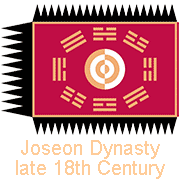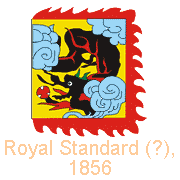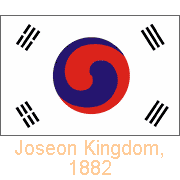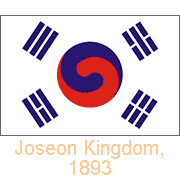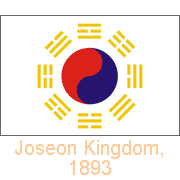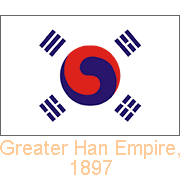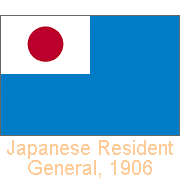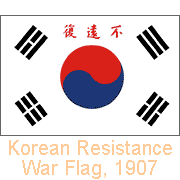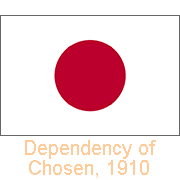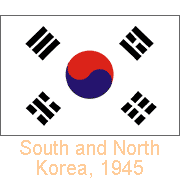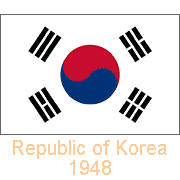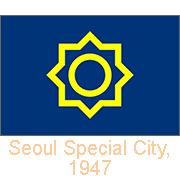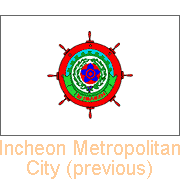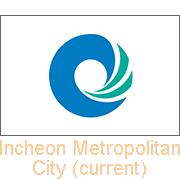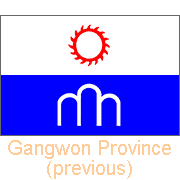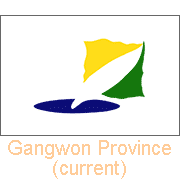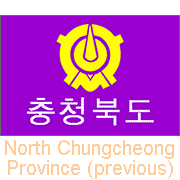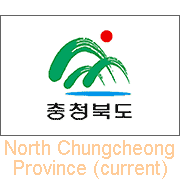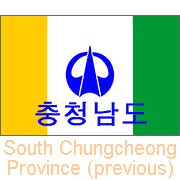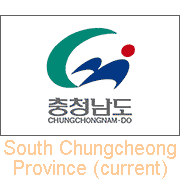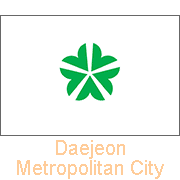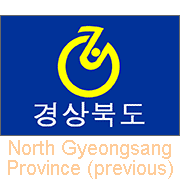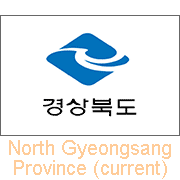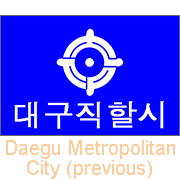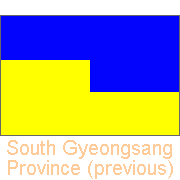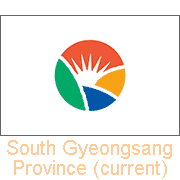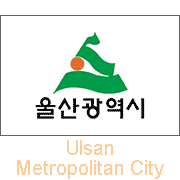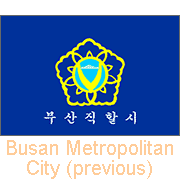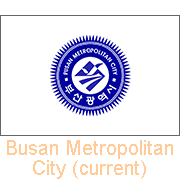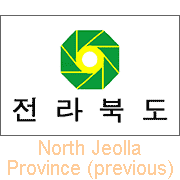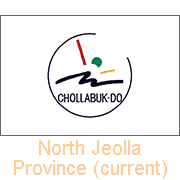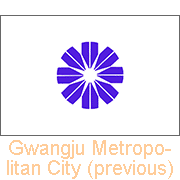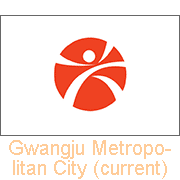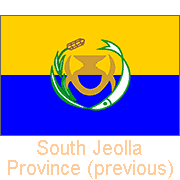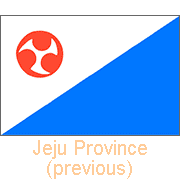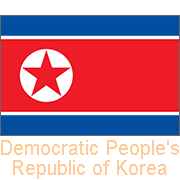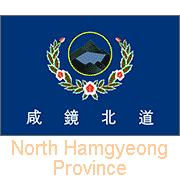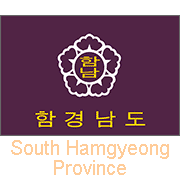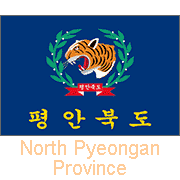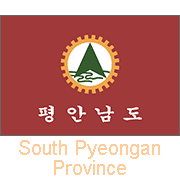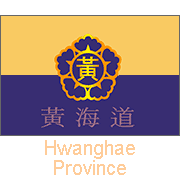Flags from Korea
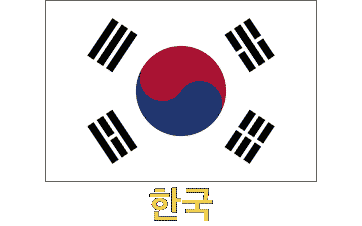
A Flag history of Korea
Although Korea did not have a National Flag until 1876, there were banners associated with the rulers of the Joseon dynasty from before 1800. For instance, the Royal Standard of King Jeongjo, who ruled from 1776 to 1800, is reputed to have been a symbol that could be considered a variant on the “Taegeuk”, two interlocking spirals in white and dark yellow on a crimson background. Surrounding this were eight “gwae”, trigrams from I-Ching, a divination system that originated around 1150 BCE in China and became of philosophical importance to Daoism and Confucianism. Each trigram comprises three bars that were either equally divided (yin) or solid (yang), representing dual cosmic forces that together symbolise cosmic harmony; each trigram is placed opposite its inverse, denoting opposites. For example, three yin (divided bars), representing earth, or mother, is opposite three yang (solid bars) representing heaven, or father; other opposites are associated with mountain/lake; water/fire; wind/thunder.
you may then send it as a postcard if you wish.
The issue of Joseon Korea not having a National Flag became a problem on the 26th of February 1876 when Japan forced the “Japan-Korea Treaty of Amity” on it: the Empire of Japan had the Japanese national flag, but the Joseon Dynasty could not hang a corresponding flag. Although independent, Korea was a tributary state of Qing China. King Gojong had asked his suzereign, the Emperor of China, for advice; the recommendation was to use a flag similar to the Chinese one, which featured a dragon on a yellow background. The Koreans did not consider that appropriate. A Japanese flag chart published in 1856 and later in 1871 showed an illustration of a red-fringed yellow flag with a black Chinese style dragon and blue clouds, labelled “Korean National flag”. But this cannot be correct because Joseon Korea did not have a national flag at that time; it may have been a proposal from the Chinese or even a Royal Standard.
The issue of not having a flag became more urgent as Korea was now forced to open up, having to deal with foreign relations, and in April 1882, an official Korean-Chinese meeting was held to discuss this matter. The “Taegeuk” emblem was proposed for the first time during this meeting. It is recorded that the Chinese delegate promoted using the Yin-Yang spiral in red and blue. Apart from it representing the dual cosmic forces of yin (blue) and yang (red), symbolising universal harmony, in which the passive and the active, the feminine and the masculine, form the whole, the colour red was that of the King, whereas blue represented ordinary people. As in the old Joseon Royal Standard, it would be surrounded by eight “gwae”, the I Ching trigrams; those also would represent the eight Korean provinces of the time.
Prince Bak Yeong-Hyo, King Gojong’s ambassador (and pro-Japanese collaborator, who later attempted to overthrow the conservative Korean government), in September 1882 drew a “Taegukgi” flag on the ship on his way to Japan. He showed it to the British captain of the ship, who thought that the design was too complicated and suggested deleting four of those eight I-Ching trigrams. He did, and Bak Yeong-Hyo used this flag for the first time on the 25th of September during his mission in Japan. He informed the king of this change the following month, and King Gojong formally proclaimed the Taegeukgi as the national flag on the 6th of March 1883. But, as there were no formal instructions on the shape of the central “Taegeuk” emblem and the arrangement of the four surrounding “gwae” trigrams, differing designs appeared in the following years. There was in 1886 even a design with the trigrams along the flag’s sides instead of in the corners. The Milwaukee Herold, a German-language daily newspaper, in October 1893 showed the flag with the trigrams in blue instead of black. According to the same publication, the Royal Korean Consulate in Hamburg, Germany, had 8 “gwae”, coloured yellow, while the “taegeuk” resembled the present design, albeit rotated.
In October 1897, King Gojong proclaimed the “Greater Korean Empire”, and its flag seems to have been unchanged; in 1899, a US Navy publication “Flags of Maritime Nations” showed the “taegeuk” with red over blue and the four “gwae” in blue. After Japan in 1905 had declared Korea a Protectorate of Japan, the following year a Japanese Resident-General Office was set up, and a light blue Resident General flag, with the “Hinomaru”, the Japanese flag in the canton, was adopted on the 14th of February 1906. Although the light-blue colour stood for “justice, fairness and philanthropy”, this certainly didn’t convince Koreans. An Army of Justice in Jeollanam-do, southern Korea, fought the Japanese under a Taegeuk flag carrying an inscription in Hanja (Chinese characters), meaning “We will soon recover national sovereignty”. Later this flag was adopted as a War Flag of the Recovery Army government (established in Vladivostok, Russia, in 1914) to fight the Japanese troops and take the country back again. The flag’s design was now very similar to that of the present flag.
On the 22nd of August 1910, the Korean Empire was abolished and annexed by Japan; the light blue Resident General flag was abolished, and the Japanese National Flag became the only legal flag in Korea. However, during the 35 years of colonial rule, Korean nationalists kept using the “Taegeukgi” as their symbol in the struggle for independence; various independentist flags were used, with minor differences. Finally, after Japan had surrendered to the Allies on the 15th of August 1945, US troops established the South Korean Military Administration. The Taegeukgi flag became once more the Korean flag in the south and the north, occupied by the Soviet Union, which became a socialist republic. In 1947 however, the Soviets believed that the flag needed to be changed, as the old flag with its traditional Korean elements was not considered suitable for a communist country. Kim Tu-bong, who was the Vice-Chairman of the Provisional People’s Committee for Northern Korea at the time, was in favour of keeping the Taegeukgi. But, after he had explained its meaning to a Soviet Major General, Lebedev, an order came from Moscow a few months later, and the design of a new North Korean flag was dictated over the phone! In July 1948, the Northern Korean People’s Assembly formally voted to adopt that new flag and the Taegukgi was taken down. Its design, by an unknown Soviet official in Moscow, is, with the typical North Korean penchant to rewrite history, now presented as the creation of Kim Il-sung, the “Eternal President of the Democratic People’s Republic of Korea”, himself. In 1967, Kim Tu-bong was purged by Kim Il-sung, and any mention of the use of the Taegeukgi was removed from texts and doctored out of photographs.
The current South Korean flag was declared official by the government of South Korea on the 15th of October 1949 and, with some minor adjustments, has remained the flag ever since. The white background stands for the nation, light and purity, reflecting the Korean people’s traditional affinity for peace; the circle stands for the people and the four trigrams for the government. The “Taegeuk” is red, “yang”, positive; and blue, “yin”, negative: dual cosmic forces symbolising universal harmony, in which the passive and the active, the feminine and the masculine, form the whole. The four “gwae” trigrams of Geon, Gon, Gam, and Ri, which surround the Taegeuk, denote the process of yin and yang going through a series of changes and growth. Geon, three solid bars in the top hoist, denotes heaven, justice, father, spring and east; Gon, with three divided bars in the lower fly, denotes earth, vitality, mother, summer and west; Gam, with one split bar on each side of one solid bar in the upper fly, denotes water, wisdom, son, winter and north; and Ri, with one solid bar on each side of one split bar in the lower hoist, denotes fire, fruition, daughter, autumn and south. All these symbols together represent universal harmony and unity.
Each subdivision in South Korea has its own flag - the Provinces, Metropolitan Cities and Special Cities. These have recently undergone changes in that many now have modernistic logos. Some have texts denoting the full name of the province or city, sometimes even with a slogan in English! (Most of the information on the previous and present regional flags is courtesy of Flags of the World). And as South Korea does not recognise North Korea as a sovereign nation, a Committee for the Five Provinces in the North has been formed, keeping the administrative division that existed in Korea before 1945, although those no longer exist on the ground. Each of those provinces has been allocated a flag, but this has no significance inside present-day North Korea. The desire to reunite remains great but seems a distant prospect with the present regime in the north.


